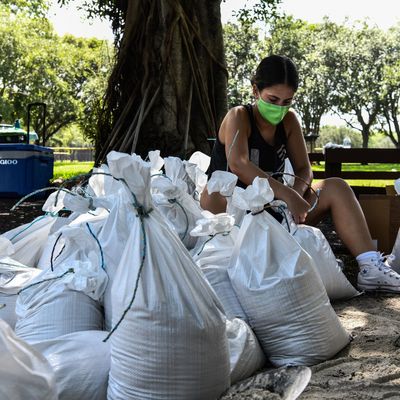
The first few months of natural disasters in the calendar year are largely confined to inland regions of the United States — flooding in the breadbasket, tornadoes in the plains and the Southeast’s interior. Though the country was mostly spared catastrophic flooding — like last year’s surge that affected some 14 million people living along the Missouri River and its tributaries — warm weather and high pressure resulted in a throng of tornadoes over Easter weekend, with 140 touching down in ten states, resulting in emergency declarations in Louisiana, Mississippi, Alabama, Georgia, and South Carolina. It was the deadliest outbreak in six years, with 38 Americans killed. On the same two days the tornado touched down, some 2,955 Americans lost their lives to the coronavirus.
The thousands of Americans whose homes were damaged or destroyed in the Easter storms faced a daunting challenge: home insecurity amid a pandemic, mass unemployment, and an emergency system inundated with coronavirus-related calls. Almost four months later, with the pandemic surging in the absence of a federal response, that trifecta may soon return, if this weekend’s severe weather events are any indication.
It began when Hurricane Isaias, downgraded to a tropical storm just after sweeping through the Bahamas, crept up the Florida coastline, closing COVID-19 testing sites in 23 counties and causing 1.1 million people in Miami-Dade County to lose electricity on Sunday. (That same day, the county reported 1,483 new coronavirus cases, down from a single-day record of over 3,000 last week.) Isaias is expected to make landfall around 8 p.m. on Monday in the Carolinas, where the National Hurricane Center warns of a “dangerous storm surge” of up to four feet over a 220-mile stretch of coastline representing some of the hardest-hit localities in the country. (Charleston, well within the potential surge zone, had the worst per capita outbreak in the world at one point last month.)
Though Isaias is gaining strength as it crawls northward, it appears to be limited in its ability to cause damage in the United States — though, tragically, the storm did kill two people as it battered the Dominican Republic. But if a major hurricane hits the United States between now and the end of the season in late November, the disaster will be compounded by the strain on emergency resources already in use — as well as the need for social distancing at Federal Emergency Management Agency shelters, which are required to cut capacity by as much as 60 percent. If a storm hits a city inundated by the virus, resulting injuries will further strain hospital systems already stretched to capacity. And even if Gulf states like Mississippi, Louisiana, and east Texas manage to wrangle their caseloads in the coming weeks, a hurricane could be a multiplying factor for outbreaks, as residents scramble together in close contact.
On Saturday, as Brevard County inmates filled sandbags in central Florida in preparation for Isaias, inmate firefighters in southern California fought to quell the Apple fire, which has burned over 20,000 acres in Cherry Valley 75 miles east of Los Angeles. Already, it has displaced 7,800 Californians; as of Sunday night, it is just 12 percent contained. While the Red Cross aims to provide shelter for those without it, the agency is reportedly having trouble doing so while maintaining proper social distancing: As of Sunday afternoon, it was only able to place 40 people, or .05 percent of those evacuated, in hotels. Such a challenge would be magnified substantially in a wildfire as large as those from recent years. In 2017, the Mendocino Complex fire burned 23 times the acreage that the Apple fire has churned through so far.
While the warming of the planet is expected to bring us into contact with pandemic-level contagions more frequently over the next century, it’s also creating conditions for more disastrous weather events in our own time. Water temperatures in the Gulf of Mexico this year are 1.6 degrees Celsius above average, a warm-up that leads to larger, stronger, and slower storms; the last time the Gulf was this warm was in 2017, when hurricanes Harvey and Maria caused hundreds of billions of dollars in damage. (It’s hard to imagine how the disasters may compound if the negligence of Trump’s Maria response meets his dereliction of duty during the pandemic.) In the West, meanwhile, the National Interagency Fire Center predicts that the fire potential for the season is “above normal” in broad sweeps of northern California, southern Oregon, most of Montana, and every county in Nevada.
Long reliant on inmate firefighter crews denied employment in the field upon their release, California is facing a challenge this year that wraps the overlapping nature of the pandemic, climate disaster, and the carceral state into one horrific package. At the end of July, the state’s reserve of incarcerated firefighters was down by 9 percent after Governor Newsom relieved crowding in state prisons by releasing 10,000 nonviolent offenders — the same pool from which Cal Fire’s prisoner brigade draws its recruits, who are paid between $2 and $5 per day, plus $1 per hour when they’re fighting fires. As of mid-July, 30 of California’s 77 inmate fire crews were in lockdown due to coronavirus outbreaks in their camps.






























